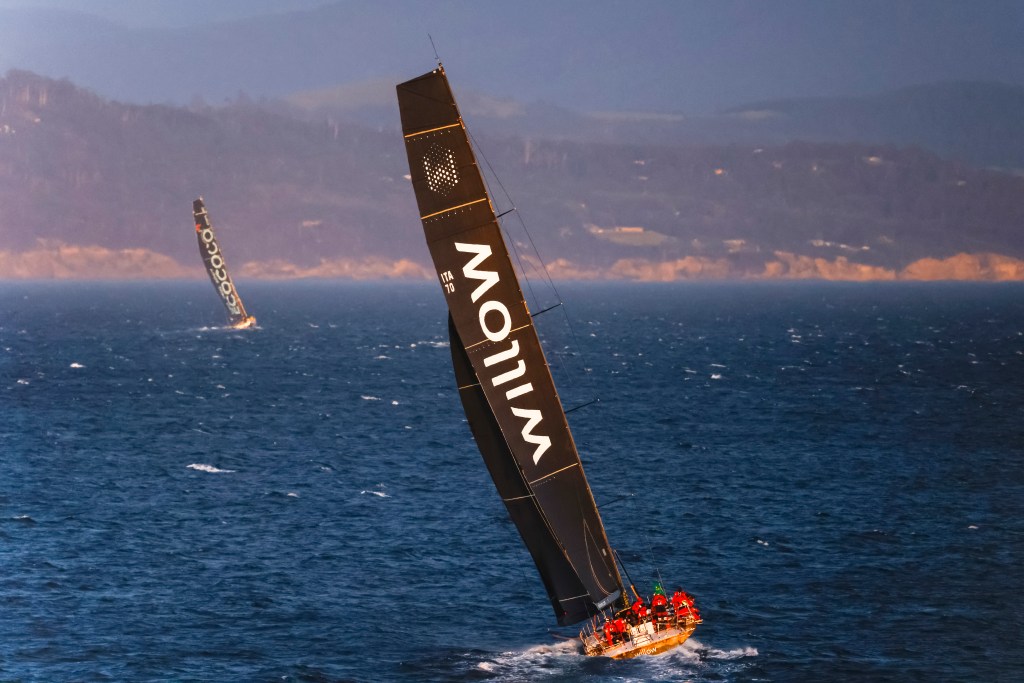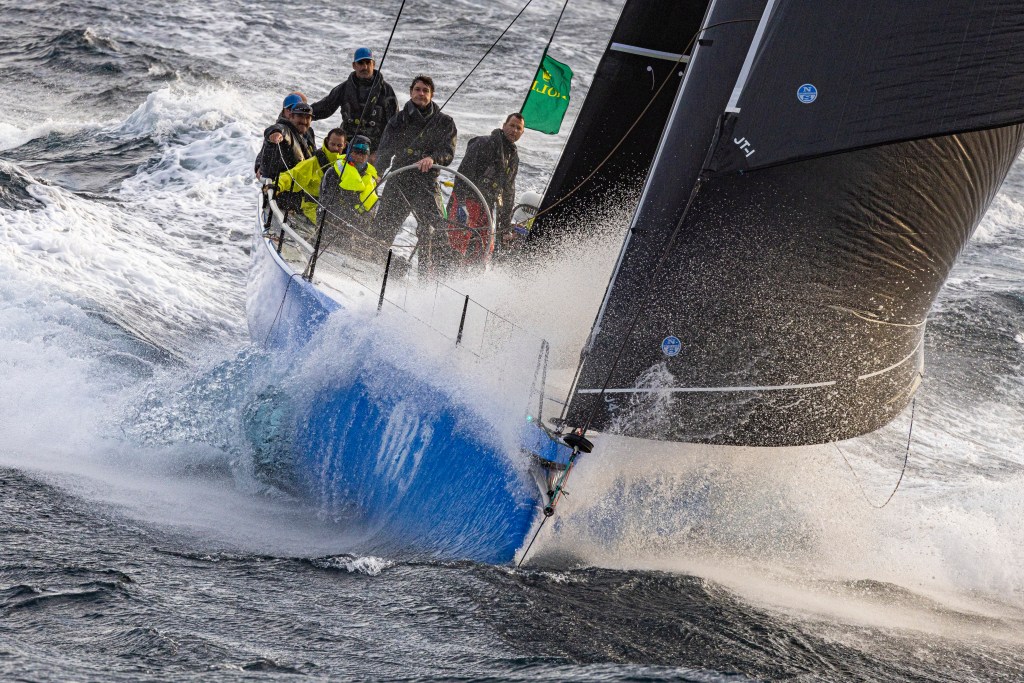Australia’s iconic Boxing-day ocean race, THE ROLEX SYDNEY HOBART, is almost 80 years old. Stewart Hawkins talks to the Cruising Yacht Club of Australia’s CEO about how she runs the event and one of Australia’s most accomplished sailors about his passion for the sport and what keeps him coming back to compete in the “Great Race”.

Cruising Yacht Club of Australia CEO Justine Kirkjian has a succinct opinion on why the Sydney Hobart is yachting’s pinnacle: “It just [represents] the Australian way.”
“It’s all about challenge, mateship and camaraderie.”
This year’s event will be the 78th time the sometimes brutal, always demanding ocean race has been contested. Crews from Australia are expected to make up 110 of the 120-strong field with international entries including boats from NZ, Hong Kong, France, Germany and the US.
The diverse field for the 628 nautical mile race will see small, 30-foot two-handed boats sailing alongside four 100-foot maxis: Wild Thing 100, SHK Scallywag, Law Connect and Andoo Comanche.
Kirkjian has spent her life on the water, and if anyone can talk about the passion that sailing can evoke, it’s her. It started at age five when her brother’s junior sailing crew member didn’t turn up one day, and she was “subbed in”.
“I was a strong swimmer, so there was no problem,” she deadpans.
“When I came in [from the race], I said to my mom that was tops (and as you did in the eighties, guess), and that was it for me. I had the bug. So yeah, I just love it. I think it’s just like… freedom.”
That passion saw her join Yachting NSW back in the ’90s as she was finishing university, then the Royal Sydney Yacht Squadron and then she spent the better part of 23 years at the CYCA, first as Sailing Manager and then as CEO from 2020. According to Kirkjian, one of the (many) joys of her job now is the atmosphere on race day in Sydney.
“If you could bottle the feeling people have when they’re here on Boxing Day, you would make a fortune,” she says.
For those taking part, the experience can be extraordinary. It’s extraordinary enough that many keep coming back to do it again and again – despite the hardship. And that hardship is real. Frighteningly so. It is, by all accounts, one of the toughest races in the world. As Olympic gold medallist and three-time Rolex World Sailor of the Year winner Tom Slingsby puts it: “It’s not the longest [race], but Bass Strait is notorious for huge waves, for a lot of wind and big southerly buster fronts. And the currents there are tricky – a real battle of attrition.”
In Kirkjian’s opinion, the event is a “bucket-list ocean race”, which many in the sailing community aspire to do at least once in their lives. But once you’ve done it once, it can be hard to stay away.
“A lot of the times you get bitten, so you do one, and you think you’ll just do one, but then… We have one man this year who’s doing his 50th consecutive race,” she says. “Other people have told me it’s a bit like childbirth that you forget how bad it was afterwards, and you come back,” she smiles.

THE PRO
Slingsby is another repeat race competitor. On top of his Olympic gold medal, he has won nine world championships and the America’s Cup. But he says until he’d completed a run to Hobart, his peers in Australia didn’t consider him a “real” sailor.
His sailing baptism was different to Kirkjian’s but had the same result. “I remember at five years old, out the front of our house, [my dad] put me in a friend’s boat and pushed me off by myself, and I was screaming and crying and saying, ‘Let me back in. I want to get off.’ Each time I went past the jetty, I had a few less tears, and by the end, I was smiling and carrying on. From then on, I loved sailing,” he says.
However, he admitted that he’d never really been that into ocean racing – until he got bitten. “I set off down the Olympic path and then the America’s Cup campaigns. But whenever I returned to Australia, everyone would say, ‘Oh, so you’re a professional sailor. How many Sydney to Hobarts have you done? Or how many have you won?’ They didn’t care about the Olympic gold medal, the America’s Cup, or any of that. They thought I was a fake if I said that I hadn’t done a Sydney to Hobart.”
He says he completed his first Sydney Hobart in 2013 and was “hooked” after that. He returned each year until, in 2016, he was on the boat that broke the race record and won – Perpetual Loyal, skippered by Anthony Bell. And even that wasn’t enough, so he did a few more.
Slingsby’s career is looking pretty solid right now. He’s recently been made a Rolex brand ambassador, is dominating SailGP and is currently living in Barcelona and expecting the birth of his first child. The downside is that he’s going to miss this year’s Sydney Hobart.
“I will do another Sydney to Hobart [though],” he says with absolute conviction. “You can’t come back to Australia and live in Sydney as a sailor, a professional sailor, and hang around on Boxing Day and put your feet up. All your mates will con you into it. In the sailing circles, we call it the Great Race.”
THE LOGISTICS
So. How do you actually put on “The Great Race”? At the end of the day, the CYCA is a yachting club with a charter to look after members and do everything from running a sailing school to managing food and beverage outlets. There’s no international sporting body backing it up when it comes to this event.
The first thing Kirkjian quips back with when I ask this question is the club’s had a lot of experience; this is, after all, the 78th race. “I think we’ve got a good process in place,” she says.
“We’re always looking to make the race a little bit better, both on and off water. When I first started here, it was a yacht race, and it’s now an event. It’s the off-water side of things we’ve tried to build on and to have a race village surrounding both the Sydney and the Hobart end.”
But as exciting and engaging as the race is, Kirkjian admits there is a dichotomy – she says she feels like she has two jobs.
“You’re running a yacht club, and you’ve got to make sure that all ticks. If someone’s just a twilight sailor, that’s as important to them as the Sydney Hobart is to others.
“It is about having strong people around you. When I stepped up into the role as CEO, I made sure I had someone in mind who could take on my sailing manager role that I would be comfortable handing that over to [and that] what I had put in place over the past 19 years was kept that way.”
But the key for Kirkjian is her volunteer base. By her estimation, the club has only 22 full-time employees, with more casuals mainly in the food and beverage and marina side.
“We are fortunate to have volunteers from the board of directors right down to assisting with on-water race management.”
The evolution of the race has seen onshore infrastructure grow substantially bigger over the years, including a “race village”, which is in situ for most of December. That’s where the club house’s media and hosts pre-race functions, cocktail parties and an information centre. “I guess it was a race for competitors previously,” she says, “And whilst we’re very mindful of that, we also want to be able to bring the race to the people.”
THE VULGAR QUESTION
But I had to ask. So, how do you bankroll it? This has got to be an expensive race – what does it cost? Kirkjian confirmed – a lot. “A lot more than people expect,” she added.
“We are very lucky that our operating expenses [are] kept low with having volunteers. We couldn’t do it if we had to pay all the volunteers.
“Within the club, we have quite a few revenue streams. We have a large marina that we lease from NSW Maritime, and then we on-lease those births to members.
“And then we’ve got food and beverage. We try to keep the costs associated with being involved in yacht racing as low as we can. Our strategy’s always been to keep racing as cheap as possible and work through other avenues to make money.”
Kirkjian was at pains to point out, quite justifiably when you crunch the numbers, the club simply couldn’t put on the event without sponsor support – it’s just too big. While acknowledging all the club’s partners, she highlighted Rolex’s 20 years with the event.
“To have someone like that involved is just phenomenal,” she says.
Look back on the week that was with hand-picked articles from Australia and around the world. Sign up to the Forbes Australia newsletter here or become a member here.


